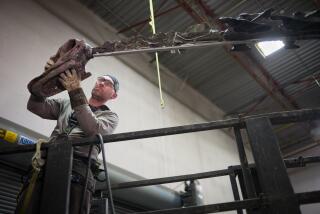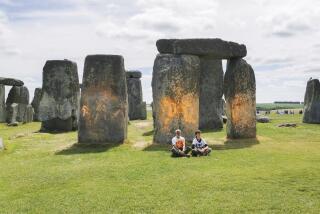Saving this dinosaur took a skeleton crew
The urgent message went well beyond Robert Painter’s usual areas of legal expertise — personal injury, commercial disputes, medical malpractice.
In less than 48 hours, the skeleton of a Tyrannosaurus bataar, a fierce cousin of Tyrannosaurus rex, would be up for auction.
“Sorry for the late notice,” the email said. “Is there anything we can do to legally stop this?”
The president of Mongolia, whom Painter had met 10 years before at a public policy conference, was now asking the Houston lawyer to block the sale of a fossil that scientists believed had been looted from the Gobi Desert. The auction catalog described the specimen:
“The quality of the preservation is superb, with wonderful bone texture and delightfully mottled grayish bone color. In striking contrast are those deadly teeth, long and frightfully robust, in a warm woody brown color, the fearsome, bristling mouth and monstrous jaws leaving one in no doubt as to how the creature came to rule its food chain.”
The sheer size and condition of the fossil seemed guaranteed to fetch a seven-figure price. When Painter read the email May 18, it was already 6:30 p.m. on a Friday. The auction was Sunday.
In the days that followed, Painter, a New York auctioneer, a Texas judge, federal prosecutors, the Mongolian president and a self-described “commercial paleontologist” would come together somewhat like the skeleton they were fighting for, disparate parts brought together through dogged effort and mysterious circumstances.
The fight would play out in federal courts in a case known as United States of America vs. One Tyrannosaurus Bataar Skeleton.
***
Since 1924, the Mongolian constitution has classified dinosaur fossils as “culturally significant,” meaning they cannot be taken from the country without government permission. Over the years, the punishment for illegally keeping or smuggling dinosaur bones has varied from up to seven years in prison to 500 hours of forced labor or paying up to 500,000 tugriks, the Mongolian currency. (That’s about $356.50.)
Cultural heritage is a sensitive subject for a people who, their history of Genghis Khan’s empire-building notwithstanding, saw powerful, aggressive neighbors invade their lands repeatedly.
After advertising for the auction caught the attention of paleontologists worldwide, Mongolian officials and journalists quickly learned of the fossil with the “delightfully mottled grayish bone color.”
“The dinosaur has the color of the Gobi sand,” said Oyungerel Tsedevdamba, an advisor to Mongolian President Tsakhiagiin Elbegdorj. “Such color is very particular and familiar to us and belongs to this country.”
On May 18, as Tsedevdamba was preparing to leave her home in the Mongolian capital, Ulan Bator, for a meeting, her husband, a science enthusiast, pointed out a news report he’d found online: A Tyrannosaurus bataar was going to be auctioned in New York.
Auctioned fossils are usually too expensive for universities to buy, and private sellers typically don’t provide enough details on how or where they got them. That leaves many of the bones in the hands of wealthy fossil buffs, or museums that look the other way.
“Technically, public institutions are neither ethically allowed to own poached specimens, nor are scientists supposed to publish on poached specimens,” said Philip Currie, a University of Alberta paleontologist who studied the Gobi Desert region for 15 years. “In other words, they become scientifically useless.”
The Tyrannosaurus bataar was 24 feet long, stood 8 feet high and weighed two tons. Still, the beast was only two-thirds grown when it died 70 million years ago.
Though it never grew into a 34-foot adult, the Tyrannosaurus thrived on the abundant prey attracted to the Nemegt Basin, then a lush river plain that straddled what is today the Gobi Desert on the Mongolia-China border. The carnivore’s main competitors were its own kind.
The creature’s jaw still carries bite marks, apparently inflicted by another Tyrannosaurus bataar.
These predators were “scrappy,” Currie said. “They weren’t overly playful.”
After her husband pointed out the news story, Tsedevdamba opened her email to alert the Mongolian Academy of Sciences’ representative in New York, but the representative had already sent her a panicked note asking what to do about the impending sale. She quickly scheduled a meeting with President Elbegdorj.
Soon after, the representative relayed a demand from the president to Heritage Auctions: Cancel the sale. The auction house refused.
The Mongolian government turned to Painter. He had done some work for the Mongolian government in the past, but “I’ve never done anything to do with dinosaurs before.”
His first challenge that Friday evening was finding a judge. Though the auction was to take place in New York, Heritage Auctions is based in Dallas, so he reached out to colleagues there. After about 20 calls, success. A judge agreed to see him Saturday.
But he still had to craft his legal arguments. Throughout the night, every court document Painter drafted was sent to Mongolia to be translated and approved by the president. He finished the paperwork at 3 a.m.
After a bit of sleep, Painter flew to Dallas and by 11:32 a.m. had the signature of Dallas’ 44th Civil District Court Judge Carlos Cortez approving an emergency temporary restraining order to stop the sale. A process server delivered it to Heritage Auctions’ New York office.
By Saturday afternoon, Painter was boarding a plane for New York.
The auction was less than 24 hours away.
***
“The sale of this next item will be contingent upon a satisfactory resolution of a court proceeding dealing with this matter,” the auctioneer said.
Painter watched from his seat in the audience at Heritage Auctions’ Park Avenue office. A photographer and videographer Painter brought along documented what happened next.
The auctioneer, referring to the imposing display at the back of the hall, continued: “This is the signature item, a crown jewel item … the Tyrannosaurus bataar skeleton.”
Bidding started at $875,000, then picked up, the auctioneer rattling off the numbers.
“I’m sorry,” Painter said, standing up. “I have to stop this.”
As the video shows, the lawyer didn’t make it 10 steps before he was corralled by two auction house employees. Painter held up his cellphone and said the judge who had ordered the company to halt the sale was on the line. The employees pushed his hand away and escorted him out.
He wasn’t there to hear it, but the sale went forward. Final price: $1,052,500.
Outside the auction house, Painter gave interviews to reporters while Heritage Auctions issued a statement.
“We have legal assurances from our reputable consignors that the specimen was obtained legally,” said Greg Rohan, president of Heritage Auctions. “As far as we know, the Mongolian government has not produced any evidence that the piece originated in its territory, but the final determination will be up to the American legal system.”
The next morning, as Painter waited on the tarmac for his Texas-bound plane to take off, his phone rang for the umpteenth time. Probably another reporter, he thought.
It was the U.S. attorney’s office for the southern district of New York.
Would the Mongolian president, the prosecutors asked, want to help with their investigation?
***
After the frenzied two days leading up to the auction, the next events unfolded over months, not hours.
Documents turned over to federal authorities by Heritage Auctions led investigators to Eric Prokopi, owner of Everything-Earth.com and a commercial paleontologist who sold fossils. Prokopi said he had purchased the skeleton legally from a dealer in England and had spent a year assembling the bones at his home in Gainesville, Fla.
On June 5, the courts agreed to allow an international panel of scientists to examine the Tyrannosaurus. Among them were Currie, the Mongolian science representative and paleontologists from San Diego, England, China and Belgium.
Painter also attended. “I would just stop and look at it and think of all the places that thing had been,” he recalled.
The panel was in virtual unanimity: The Tyrannosaurus bataar must have come from the Nemegt Basin in Mongolia.
The bones’ shapes and color, matching the Gobi sand just as Tsedevdamba had said, were trademark Asian dinosaur characteristics. North American dinosaur bones are frequently dark brown or even black. The experts said the skeleton most likely had come from an area known as the Dragon’s Tomb.
The government moved to seize the dinosaur in June and filed smuggling and other charges against Prokopi in October. Last month, Prokopi, 38, admitted that the skeleton originated in Mongolia and pleaded guilty to smuggling and other charges. Authorities seized other fossils, including two more Tyrannosaurus bataars and a hadrosaur. Free on $250,000 bail, he is scheduled to be sentenced in April and faces up to 17 years in prison.
Amid the controversy, the winning bidder backed out of the purchase.
The Tyrannosaurus bataar eventually will be returned to Mongolia, but for now the bones are stored in several crates at a windowless, bricked-up government warehouse in Queens known as the Fortress.
And in Mongolia, officials are considering declaring May 20 — the day of the auction — Dinosaur Heritage Day.
More to Read
Sign up for Essential California
The most important California stories and recommendations in your inbox every morning.
You may occasionally receive promotional content from the Los Angeles Times.











